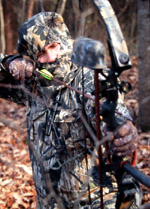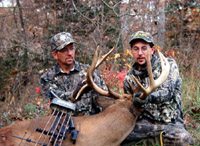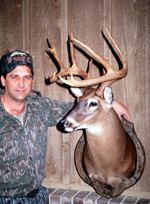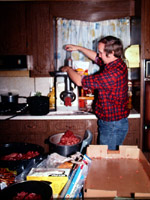
|
Features
|
|
|
|
Books
|
|
|
|
Fun & Games
|
|
|
|
Contact Us
|
|
|
John's Journal... Entry 124, Day 3
AFTER THE SHOT
Processing Your Venison Yourself
 EDITOR'S
NOTE: The decisions you make once your game is down are what make
for the best of memories or the worst of nightmares. This week we'll look
at the best ways to take care of your deer once you bag it.
EDITOR'S
NOTE: The decisions you make once your game is down are what make
for the best of memories or the worst of nightmares. This week we'll look
at the best ways to take care of your deer once you bag it.
Most of us think we can save that money by processing
our meat ourselves. Perhaps you can, if you own a meat grinder and a cuber,
have the seasonings readily available for making sausage, have access
to beef and pork fat, as well as a place to hang the deer while it ages
and a way to keep the meat cool while you process it and don't consider
your time worth anything. If you want to know the costs involved for you
to process your deer, multiply what you earn per hour at your regular
job by the number of hours you'll need to work to have the meat ready
for the freezer and the cost of the equipment to process the meat into
hamburger, sausage, etc.
However, many outdoorsmen enjoy working with venison from the deer they've
bagged and employing creative ways to prepare this meat. My wife and I
consider ourselves experts on preparing venison, since we have eaten as
many as 13 deer in a year.
 Field
Dressing: To have delicious-tasting venison, always field dress the deer.
With the deer's head uphill, carefully remove the entrails, making sure
not to puncture any of the organs inside the chest cavity. Once you clean
out the cavity, some hunters like to wash out the cavity. But I don't,
because bacteria will set up quicker when the cavity is washed than if
you allow the deer to drain clean of the blood. When you finish field
dressing the deer, keep the body cavity clean and cool. Carry your deer
in the bed of a pickup truck, or strap it to the roof of a jeep. With
a car, you can put the deer in the trunk, if the weather's very cool,
or strap it on the roof. Never, never strap your deer to the hood of any
vehicle. The heat from the engine will ruin the meat. Use small twigs
to prop open the walls of the chest cavity to naturally cool the meat.
If you live in a very cold climate, you can hang the deer outside to age.
I prefer to hang my deer from the head. You may like to age your deer
by hanging it in a cooler that has a constant temperature of less than
40 degrees for a week to 10 days. Leave the hide on as the skin acts as
a protective covering, preventing the meat from drying out and losing
flavor.
Field
Dressing: To have delicious-tasting venison, always field dress the deer.
With the deer's head uphill, carefully remove the entrails, making sure
not to puncture any of the organs inside the chest cavity. Once you clean
out the cavity, some hunters like to wash out the cavity. But I don't,
because bacteria will set up quicker when the cavity is washed than if
you allow the deer to drain clean of the blood. When you finish field
dressing the deer, keep the body cavity clean and cool. Carry your deer
in the bed of a pickup truck, or strap it to the roof of a jeep. With
a car, you can put the deer in the trunk, if the weather's very cool,
or strap it on the roof. Never, never strap your deer to the hood of any
vehicle. The heat from the engine will ruin the meat. Use small twigs
to prop open the walls of the chest cavity to naturally cool the meat.
If you live in a very cold climate, you can hang the deer outside to age.
I prefer to hang my deer from the head. You may like to age your deer
by hanging it in a cooler that has a constant temperature of less than
40 degrees for a week to 10 days. Leave the hide on as the skin acts as
a protective covering, preventing the meat from drying out and losing
flavor.
 Butchering:
When you're ready to butcher the deer, skin the animal. Then start on
the inside of the stomach cavity where two small round rolls of meat run
midway from the spine toward the anal area. These two tenderloin rolls
are some of the tastiest meat in the deer. Next remove the two loins,
sometimes called backstraps, by cutting along the spine on either side
of the backbone into the front shoulder region and into the top of the
hindquarter. Cutting the loin into very thin strips down to the gristle
and then cutting the gristle away gives you some of the finest venison
steak possible. Next disconnect the shoulders, and finally separate the
two hindquarters. Meticulously separate out each muscle of the hindquarter,
and cut the meat away from the gristle. Although this chore is time-consuming,
removing the gristle and other connecting tissue from the muscle makes
the venison much more tender and gives it a better flavor. This meat can
be rolled and bound with a cord to make a delicious rump roast or sliced
thin into steak. Freeze the venison carefully by wrapping it in freezer
paper, and then mark it with a pen. If you freeze an abundance of meat
at one time, be sure that all of it freezes as soon as possible.
Butchering:
When you're ready to butcher the deer, skin the animal. Then start on
the inside of the stomach cavity where two small round rolls of meat run
midway from the spine toward the anal area. These two tenderloin rolls
are some of the tastiest meat in the deer. Next remove the two loins,
sometimes called backstraps, by cutting along the spine on either side
of the backbone into the front shoulder region and into the top of the
hindquarter. Cutting the loin into very thin strips down to the gristle
and then cutting the gristle away gives you some of the finest venison
steak possible. Next disconnect the shoulders, and finally separate the
two hindquarters. Meticulously separate out each muscle of the hindquarter,
and cut the meat away from the gristle. Although this chore is time-consuming,
removing the gristle and other connecting tissue from the muscle makes
the venison much more tender and gives it a better flavor. This meat can
be rolled and bound with a cord to make a delicious rump roast or sliced
thin into steak. Freeze the venison carefully by wrapping it in freezer
paper, and then mark it with a pen. If you freeze an abundance of meat
at one time, be sure that all of it freezes as soon as possible.
 Preparing
Venison to Eat: To prepare venison for dishes, including roasts, steaks,
ribs, etc., place frozen meat in the refrigerator in a pan with heavily
salted water covering the meat, for at least 24 hours. Then carefully
wash off all the salt before preparing. To prepare ground venison, my
family uses beef trimmings that contain some lean as well as beef fat.
We mix cool deer meat (partially frozen works well) with beef trimmings
available from the butcher's and grind together in the following proportions:
50 pounds of venison, cut into pieces; 40 pounds of beef trimmings; 10
pounds of pork trimmings. Then we grind the mixture at least twice for
a finer texture and mix the trimmings and venison thoroughly with our
hands to assure even distribution of both.
Preparing
Venison to Eat: To prepare venison for dishes, including roasts, steaks,
ribs, etc., place frozen meat in the refrigerator in a pan with heavily
salted water covering the meat, for at least 24 hours. Then carefully
wash off all the salt before preparing. To prepare ground venison, my
family uses beef trimmings that contain some lean as well as beef fat.
We mix cool deer meat (partially frozen works well) with beef trimmings
available from the butcher's and grind together in the following proportions:
50 pounds of venison, cut into pieces; 40 pounds of beef trimmings; 10
pounds of pork trimmings. Then we grind the mixture at least twice for
a finer texture and mix the trimmings and venison thoroughly with our
hands to assure even distribution of both.
To make ground venison sausage, we mix cooled or partially frozen venison with trimmings available at the butcher's. Then we grind together: 50 pounds of venison, cut into pieces; 40 pounds of pork trimmings; and 10 pounds of beef trimmings. We grind the mixture at least twice for a finer texture, and also mix the ground meat and trimmings thoroughly with our hands to assure even distribution of both. Last we mix some kind of sausage seasoning mix (we prefer Legg's Plantation Style Sausage Seasoning Mix), according to package recommendations to the ground mixture.
To learn more about preparing and cooking venison, go to Night Hawk's home page and click on books to see the "Deer & Fixings Cookbook," written by John and his wife, Denise, who now have more than 80 combined years' experience of cooking venison. Call (800) 627-4295 to order with a credit card, or you can send a check or a money order to 4112 Camp Horner Road, Birmingham, AL 35243.
TOMORROW: PICKING A TAXIDERMIST
Check back each day this week for more about what to do after the shot ...
Day 1 - Getting Your Deer
Day 2 - Choosing a Processor
Day 3 - Processing Your Venison Yourself
Day 4 - Picking A Taxidermist
Day 5 - Saving a Possibly Lost Trophy